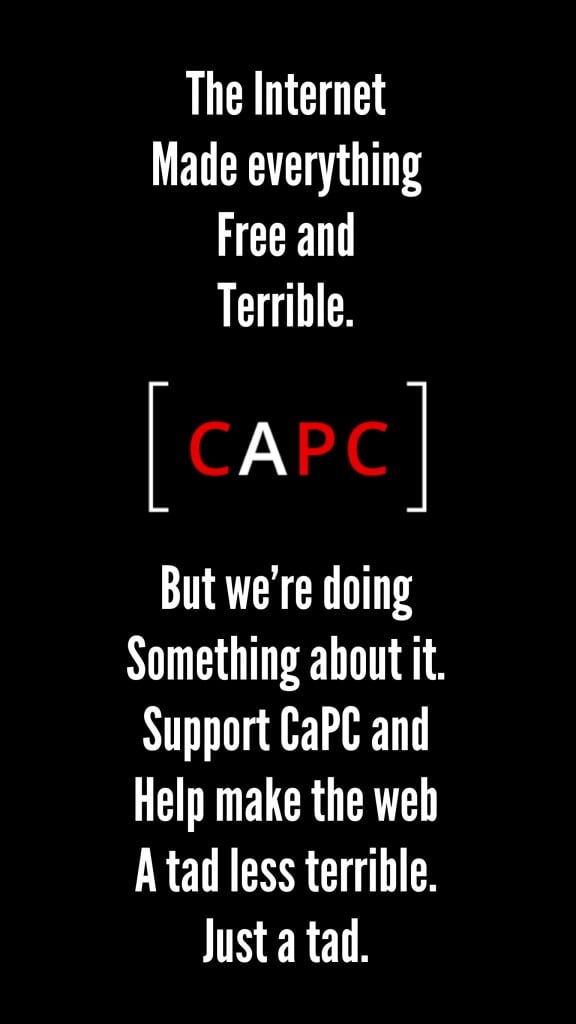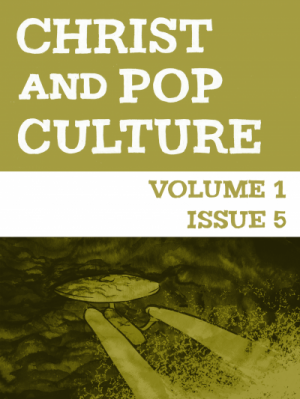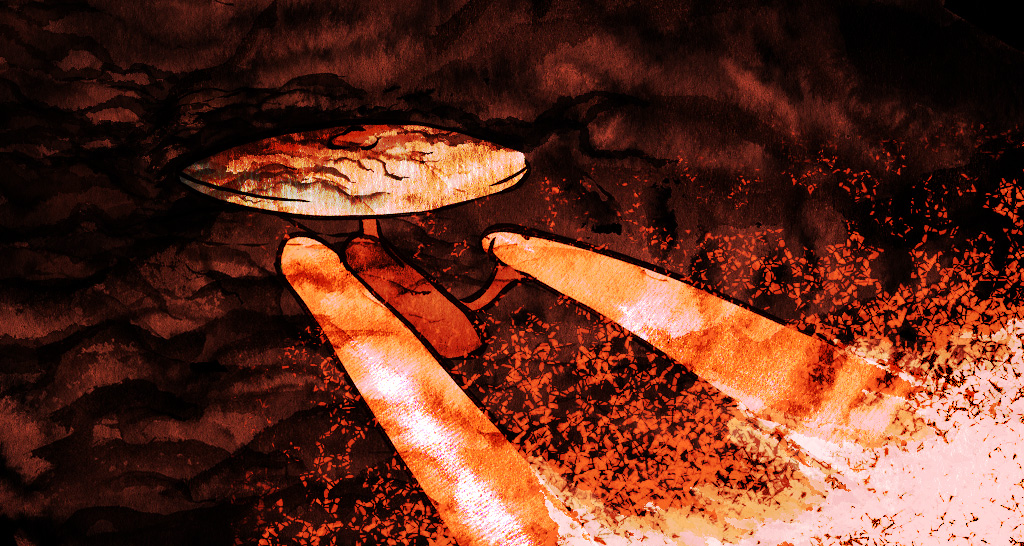The following is an exclusive feature that has been shared with you but is otherwise available only in Issue #5 of the Christ and Pop Culture Magazine. For more features like this, download our app for iPad and iPhone from Apple’s App Store.
After a one-week free trial, monthly and yearly subscriptions are available for $2.99 and $29.99 respectively. New issues are made available every other week. More information here.
The decision to name the followup to J. J. Abrams’ 2009 Star Trek reboot Star Trek into Darkness is more loaded than it may appear. Star Trek, from its original inception was in many ways a child of Enlightenment thought, a science fiction series that tended to de-emphasize aspects of darkness in human character. The future envisioned in the Star Trek mythology began as an optimistic one, and its journey into darker realms raises questions about how true a reimagining of the show could be. Much of the debate is grounded in how we understand human nature: are people born in a state of original sin, or are people blank slates, waiting for good education and nurture to improve us?
The Enlightenment and the Birth of Science Fiction
The late seventeenth and the eighteenth centuries mark an era of intellectual history in Western Civilization now commonly called the Enlightenment, which was marked by an increasing emphasis on the powers of human Reason, while downgrading other sources of knowledge such as perceived divine revelation or received tradition. Thinkers began to see organized religion as an impediment to rational thought rather than an asset and the vanguard of the Enlightenment saw their own era as perhaps the apex of human society to that point, with the potential for further advancement. The key was education: bad religious dogma perpetuated itself through bad education, but if people could be schooled rationally in Enlightenment principles from an early age, true progress could still be made.
As deists, they eschewed belief in supernatural intervention such as miracles. They focused their study on nature, from which one could derive an understanding of the rules and principles the creator has built into it, leading to our modern construction of science. This attention to the natural world became even more pronounced in the nineteenth century; the familiar sub-disciplines of science (biology, geology, astronomy, etc.) materialized, and science became unmoored from its philosophical roots. Natural science led into applied science, resulting in the advances that created that great nineteenth-century technology boom, the Industrial Revolution.
The genre we now call science fiction was born out of this environment and was at first dominated by two authors, Jules Verne and H. G. Wells. Verne wrote adventure stories derived from near-contemporary technological principles, anticipating modern developments. While Wells could do the same, his works were often more speculative in nature, and in the 1890s especially, his works helped establish many foundational science fiction concepts.
In the early decades of the twentieth century, America’s market became dominated by the pulp magazine phenomenon. Pulp stories melded the boyish gee-whiz action of Verne with the farther-future speculation of Wells to appeal to popular audiences.
Star Trek
Science fiction was well-established by the 1960s, when television writer/producer named Gene Roddenberry first pitched the concept of a “Wagon Train to the stars” to a skeptical NBC. The series, to be named Star Trek, would follow the adventures of a starship called Enterprise set approximately 300 years in the future as its diverse crew traveled the galaxy in search of previously unknown alien cultures, hoping to establish peaceful contact with them. Eventually, the main cast settled into the familiar triumvirate of Captain James T. Kirk , Commander Spock, and Doctor Leonard McCoy, along with several other regulars.
A former military and police officer, Roddenberry was well aware of the destructive capabilities humans and their technology possessed. Yet, buoyed by the optimism of the 1960s and the post-Kennedy American investment in space travel, Roddenberry held out hope for the future of earth, partaking in the cautious confidence that had always been a major wellspring of science fiction, an optimism that flowed from the Enlightenment, when Europe emerged disgruntled from religious wars with the hope of a more tolerant society, guided by human reason.
One of the hallmarks of Star Trek’s original series was the theme of human ingenuity triumphing over the machinations of seemingly god-like aliens. While Star Trek could invoke Christianity favorably, the show emphasized a humanity that, in striving to transcend its limitations, could itself evolve into something godlike. In Star Trek, there is no fundamental internal force actively counteracting human goodness—there is no Original Sin. Rather, akin to the Enlightenment understanding of humanity, the only thing that has held back human progress is poor education. The resulting picture of Star Trek’s United Federation of Planets (with Earth as its center, of course) is of a near-utopian society that faces threats that are either external or that derive from ignorance.
 Star Trek: The Next Generation (TNG), the second foray into Roddenberry’s mythology, takes many of the same humanistic premises and adapts them them for a new audience. The world of TNG is a more cosmopolitan one: the original Enterprise exemplified human ethnic diversity, but only one alien (Spock) was a member of the crew, whereas the newly configured starship Enterprise-D included not only humans of different backgrounds but several from other worlds (as well as one android). Airing in the late 1980s as the Cold War was dissolving, Star Trek: The Next Generation presented a United Federation of Planets that looked more like the United Nations than the United States. If anything, however, this new demographic only further underscored the positivism inherent in Roddenberry’s conception of his universe. While the first series suggested that humans could accomplish great things if they could only leap the hurdles of ignorance and superstition, there was a fundamental Americanism that underlay the series: the central three characters (even the alien, Spock) were essentially white males, while members of other ethnic groups played significant yet subordinate roles. In TNG, however, Roddenberry sought to portray humans as progressing toward a greater integration. Thus, the new Enterprise, while captained by the human Jean-Luc Picard, also included a crew from a variety of worlds. Kirk was a “cowboy,” a man of action who bent rules according to his judgment. But in Picard, Roddenberry created a character who was at heart a diplomat, a man who would share Kirk’s love of adventure but would seek community across larger boundaries.
Star Trek: The Next Generation (TNG), the second foray into Roddenberry’s mythology, takes many of the same humanistic premises and adapts them them for a new audience. The world of TNG is a more cosmopolitan one: the original Enterprise exemplified human ethnic diversity, but only one alien (Spock) was a member of the crew, whereas the newly configured starship Enterprise-D included not only humans of different backgrounds but several from other worlds (as well as one android). Airing in the late 1980s as the Cold War was dissolving, Star Trek: The Next Generation presented a United Federation of Planets that looked more like the United Nations than the United States. If anything, however, this new demographic only further underscored the positivism inherent in Roddenberry’s conception of his universe. While the first series suggested that humans could accomplish great things if they could only leap the hurdles of ignorance and superstition, there was a fundamental Americanism that underlay the series: the central three characters (even the alien, Spock) were essentially white males, while members of other ethnic groups played significant yet subordinate roles. In TNG, however, Roddenberry sought to portray humans as progressing toward a greater integration. Thus, the new Enterprise, while captained by the human Jean-Luc Picard, also included a crew from a variety of worlds. Kirk was a “cowboy,” a man of action who bent rules according to his judgment. But in Picard, Roddenberry created a character who was at heart a diplomat, a man who would share Kirk’s love of adventure but would seek community across larger boundaries.
TNG intensified the longstanding Star Trek theme of human interaction with godlike beings, introducing the character of Q, a member of the vastly powerful Q Continuum, to give some focus to the human-“god” dynamic so prevalent in the first series. Q first appears in TNG’s premiere, “Encounter at Farpoint,” as a stern judge skeptical of humanity’s worthiness to participate in galactic affairs. The Enterprise crew solves the conundrum with which they are tasked in that episode, but in a nice bit of symmetry, the show’s writers penned a series finale, “All Good Things,” which returns Picard to Q’s courtroom. The trial, Q here proclaims, has been ongoing, but now humanity has been declared guilty of savagery. However, in classic Star Trek fashion, Picard and company are again able to solve a puzzle, leading to Q’s final affirmation of the Enterprise and its mission and the possibility of further human evolution, making explicit a theme which was implicit in The Original Series.
Darkness
Star Trek and Star Trek: The Next Generation retained Gene Roddenberry’s steadfast faith in humanity’s ability to overcome prejudices and develop naturally toward a utopian existence. In Star Trek: Deep Space Nine (DS9), however, the dynamics changed significantly. Though the series added a starship called the Defiant in later seasons, it remained focused on the eponymous station, unlike the more mobile Enterprises exploring widely in past seasons. The show’s intricate backstory only added layers and characters as it went along, a far cry from the world-of-the-week format the two prior series had adopted. Moreover, Kirk and Picard both commanded vessels occupied entirely by Starfleet officers (and, occasionally, their families); but while Deep Space Nine required a Federation presence, it was a multicultural environment, populated by individuals from countless species, many of whom felt little obligation to Federation guidelines. As a location on both the spatial and cultural fringes of Federation space, the station Deep Space Nine was a far less homogenous place than even the Enterprise-D.
Partly as a consequence of this frontier mentality, the series Deep Space Nine was markedly darker both in visual tone and thematic content than either of the its predecessors. Co-creator Michael Piller notes that this was intentional, maintaining that his staff “really set out to create conflict on every level of this show,” including “conflict between us and the humanist values of Gene Roddenberry’s futuristic humans.” And what made Deep Space Nine different was not just a superficial darkness, but the underlying suggestion that the human population of the Federation hadn’t actually evolved as thoroughly from their baser instincts as Roddenberry’s earlier shows had maintained. Set apart from regular enforcement of regulations, pushed beyond their expectations, could people of the future respond with the same flawed reactions as people of our own era? The writers of the series pushed their characters much closer to the brink than anyone had done before; sometimes they did so in episodic fashion, but this exploration of humanity’s dark side became more regular, almost systematic, with the advent of the Dominion War.
Roddenberry’s Star Trek had always alluded to war as a phenomenon of the past. But in its final seasons, DS9 plunged the Federation into an all-out war against the hierarchical coalition called the Dominion. In the two-parter “Homefront” and “Paradise Lost,” a shape-shifting member of the Dominion’s Founders commits a terrorist act on Earth, leading to widespread paranoia and an attempted coup as one admiral tries to invoke martial law. The episode’s title is telling: 24th-century Earth under the Federation is paradise, a utopian environment, but humans have not advanced so far that they are able to maintain their new Eden. As the war progressed, moral sacrifices appear increasingly frequent, including the introduction of a Machiavellian shadow agency called Section 31 that operates with unofficial Starfleet approval. It is difficult to imagine Gene Roddenberry sanctioning the existence of such a group in his vision of Starfleet. Even aside from Section 31, however, the Dominion War could bring out the worst in people. Episodes like “Nor the Battle to the Strong” and “The Siege of AR-558” featured war veterans who were tougher and edgier than any Starfleet officers fans had seen before. And in arguably the most morally ambivalent show of all, “In the Pale Moonlight,” DS9’s Captain Sisko allows former spy Garak to lead him down a path of ethical compromises to achieve his desired ends, leaving him in the final scene desperately trying to rationalize his actions.
This is not to say that Star Trek: Deep Space Nine had polar opposite anthropology from its progenitors. The characters were capable of the kind of heroism and self-sacrifice that Roddenberry had hoped to engender. Seemingly disreputable figures could take positive steps in personal evolution toward greater selflessness. By the show’s finale, “What You Leave Behind,” Captain Sisko emerges as an almost literal Christ-figure. DS9 never went so far as to suggest anything like original sin in its human protagonists, let alone in the alien ones. If the paradise of the future could be lost, it nonetheless had been a paradise and could be one again. Still, of the five Star Trek series, none ever probed the dark regions of the human psyche so deeply or so consistently as Deep Space Nine.
Star Trek into Darkness
 Only a couple years after the cancellation of Enterprise, Paramount announced that Alias creator J. J. Abrams would be helming a Star Trek movie, with a young cast taking on The Original Series roles. Abrams’s Star Trek, which hit theaters in 2009, begins with the arrival of Nero, a member of the Romulan race. Nero (who is from a time coincident with TNG) has seen his family and homeworld destroyed, a catastrophic event that an old Spock had tried unsuccessfully to prevent. Blaming Spock for his loss, Nero emerges in the past, wreaking havoc on the timeline to the extent of destroying Spock’s homeworld Vulcan. Nero’s first arrival in the past had led to the destruction of the USS Kelvin, killing James Kirk’s father just as Kirk himself is born. Kirk grows up embittered but finds his way in Starfleet, and the movie chronicles the gathering together of the familiar Enterprise crew—including a younger Spock—as they race to defeat Nero.
Only a couple years after the cancellation of Enterprise, Paramount announced that Alias creator J. J. Abrams would be helming a Star Trek movie, with a young cast taking on The Original Series roles. Abrams’s Star Trek, which hit theaters in 2009, begins with the arrival of Nero, a member of the Romulan race. Nero (who is from a time coincident with TNG) has seen his family and homeworld destroyed, a catastrophic event that an old Spock had tried unsuccessfully to prevent. Blaming Spock for his loss, Nero emerges in the past, wreaking havoc on the timeline to the extent of destroying Spock’s homeworld Vulcan. Nero’s first arrival in the past had led to the destruction of the USS Kelvin, killing James Kirk’s father just as Kirk himself is born. Kirk grows up embittered but finds his way in Starfleet, and the movie chronicles the gathering together of the familiar Enterprise crew—including a younger Spock—as they race to defeat Nero.
The 2009 version of Star Trek is not an especially philosophical movie. As an origins movie, its purpose was primarily to renew interest in Star Trek as a franchise and to put its characters in place. In the process, however, it returns to one of the key Enlightenment themes of Roddenberry’s original concept: that humans are essentially educable. The alternate Kirk grows up without a father, leading him to be more aggressive and less stable than his counterpart from The Original Series. Even so, he is able to overcome this bad nurture to make something of himself. Indeed, by creating an entirely different timeline, Abrams and his team emphasize a form of radical free will; the universe becomes, in a sense, almost infinitely malleable. While many episodes of Star Trek had featured alternate universes or the threat of history being changed, they had always returned to the “right” timeline in the end. By leaving viewers now in the “wrong” timeline, Abrams suggests not a single, providentially-ordained history but a multiplicity of outcomes, any one of which might be valid.
Star Trek into Darkness, now operating within this altered timeline, is certainly a more substantial film than its predecessor. And in many ways, it lives up to its title. In Star Trek into Darkness, the threats come primarily from within—from within the darkness of the human heart, from within Starfleet itself. While the movie contains countless references to past Star Trek series, its two most significant sources evoke the darkest moments of Star Trek: The Original Series and Star Trek: Deep Space Nine respectively. Yet fans of Gene Roddenberry’s native optimism will find his philosophy finally reaffirmed by the film; indeed, Kirk’s final speech acknowledges the corruption that can lie within the human psyche while looking ahead to the need for conquering it.
At its richest moments, the many incarnations of Roddenberry’s Star Trek come close to acknowledging the finely-pitched balance that has always been part of Christian teaching: that humans are created in God’s image, yet tainted by original sin; both darkness and light coexist within us. For the most part, Roddenberry followed the Enlightenment path of denying sin. As such the series he had direct control over are helpful in demonstrating the innate value and ability that humans possess from their creator. But it is also unsurprising that the Star Trek franchise took darker casts as it went along, for most people recognize that the full extent of Roddenberry’s positivism was unsustainable. Humans have darkness within us, and no amount of development, individual or corporate, will free us from it. And as humanity’s savior himself said, “If then the light within you is darkness, how great is that darkness!”
Geoffrey Reiter is Assistant Professor of English at the Baptist College of Florida. He holds a B.A. in English from Nyack College and a Ph.D. in English from Baylor University, along with an M.A. in Church History from Gordon-Conwell Theological Seminary.
Illustration courtesy of Seth T. Hahne. Check out Seth’s graphic novel and comic review site, Good Ok Bad.

